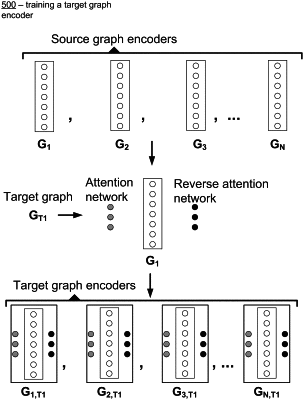| CPC G06N 3/084 (2013.01) [G06F 18/22 (2023.01); G06N 3/02 (2013.01); G06N 3/045 (2023.01); G06N 20/20 (2019.01); G06V 10/82 (2022.01)] | 20 Claims |

|
1. A computer-implemented method for determining graph similarity, the computer-implemented method comprising:
obtaining, by one or more computing devices, a plurality of source graphs and a target graph;
training, by the one or more computing devices, a source graph encoder for each source graph to generate a plurality of source graph encoders respectively associated with the plurality of source graphs, wherein the source graph encoder for each source graph is configured to predict one or more characteristics of the corresponding source graph based on an input that describes a portion of the corresponding source graph;
training, by the one or more computing devices, a target graph encoder for each source graph to generate a plurality of target graph encoders respectively associated with the plurality of source graphs, wherein each target graph encoder is configured to predict one or more characteristics of the target graph based on an input that describes a portion of the target graph, and wherein the target graph encoder associated with each source graph comprises:
an attention model configured to receive the input that describes the portion of the target graph and to convert the portion of the target graph into a portion of the corresponding source graph;
the source graph encoder associated with the corresponding source graph; and
a reverse attention model configured to receive and process an output of the corresponding source graph encoder to predict the one or more characteristics of the target graph; and
generating, by the one or more computing devices, an embedding for the target graph, wherein the embedding comprises a plurality of performance values respectively for the plurality of target graph encoders.
|